Monitoring of Resource consents
Within this section…
Activities Requiring Monitoring
In the 2007-08 financial year, NRC had 4006 active, consented activities in its database. The chart below gives a breakdown of consented activities by type.
1115 consented activities were listed for the coastal environment. These activities include structures, such as moorings and marine farms, and other activities such as earthworks and reclamations in the Coastal Marine Area (CMA). Activities relating to groundwater (389) and surface water (355) include take, use, damming or diversion of water and activities relating to air (88) include the discharge of particulates, smoke or other such emissions. Land-use activities (391) include earthworks, vegetation clearance and land preparation. Many of these tend to be short term and relate to one off projects, such as subdivisions or roading.
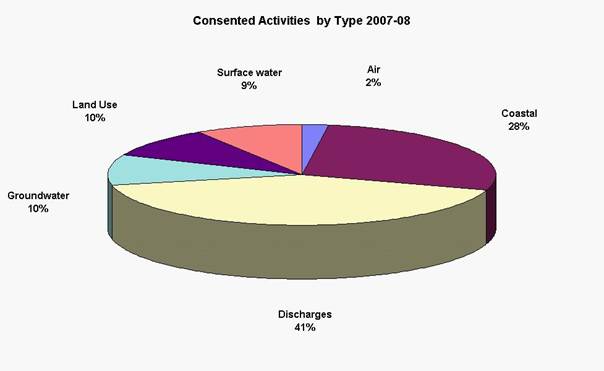
The highest percentage of consented activities relate to the discharge of a substance into the environment (1668 activities). This category includes discharges to land or water (including coastal waters), such as stormwater, sewage or farm dairy effluent (FDE).
The number of consented activities recorded for the purposes of monitoring does not represent the number of resource consents issued by NRC and active during the financial year, as a single consent document may cover all activities required for a given proposal. For example, a single consent document may include vegetation clearance, earthworks and stormwater discharge activities at a single site.
Compliance Monitoring Assessments
All resource consents contain conditions which regulate how the consented activity should be undertaken, in order to prevent or minimise any adverse impact on the environment. The consent holder is legally bound to abide by these conditions.
In Northland, monitoring to check compliance with consent conditions is governed by NRC's Environmental Monitoring Quality Manual. Monitoring requirements are different for each consented activity and are based on the duration of the activity, the scale of the activity and the potential for it to affect the receiving environment.
Not all consented activities require monitoring as some may have little or no impact on the environment. Activities which are low risk but which occur over a longer period of time may require monitoring on an occasional basis, for example, once every two to five years. Activities with the potential to have a significant impact on the environment, either in the long or short term, require monitoring on a more frequent and regular basis.
Monitoring is largely undertaken by NRC staff however in some instances, it is more appropriate for the activity to be monitored by the consent holder (termed ‘self-monitoring'). Where consents are self-monitored, NRC staff may also undertake random site visits in order to audit the received information against the activity on the ground. In addition, monitoring may be undertaken in response to an "incident" call on the NRC Environment Hotline, which could be an indication that an activity is not being undertaken in line with the conditions of the resource consent.
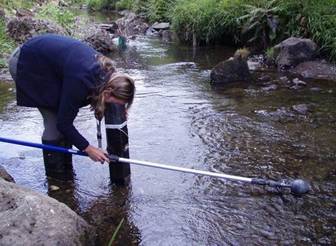
Photo: Council employee measuring water clarity downstream of a discharge
During the 2007-08 financial year, 3002 compliance assessments were made by council staff. This compares to 2788 in 2006-07 and 3149 in 2005-06. The chart below compares the number of assessments made each financial year from 2005 – 2008 based on type of activity monitored.
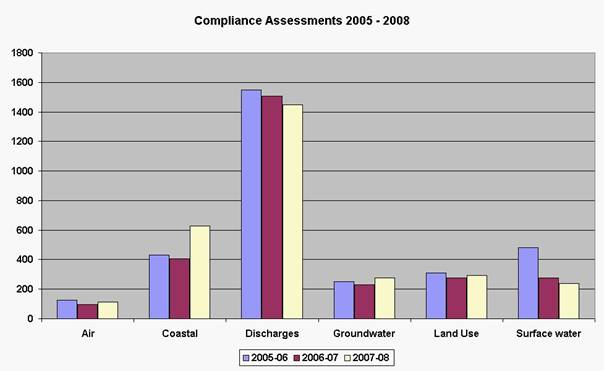
As can be seen, the number of monitoring assessments undertaken for each activity group is proportional to the number of consents issued for that type of activity.
Compliance Assessment Results
The results from each compliance assessment are graded using the criteria given below.
| Compliance Level |
Description | Effect |
CL1 |
Full Compliance | Within consent limits |
| CL2 | Minor non-compliance - Self Monitoring information or one-off data is incomplete or outstanding | Evidence of minor actual or potential for minor effect |
| CL3 | Minor non-compliance -Poor system maintenance and/or construction, or monitoring information indicates minor non-compliance. | |
CL4 |
Combination of CL2 and CL3 | |
| CL5 | Significant Non-compliance | Evidence of significant effect or potential for significant effect OR ongoing/repeated minor non-compliance (i.e. more than two) |
| CL6 | Significant Non-compliance | Uncontrolled discharge, major effect or potential for significant effects |
During the 2007-08 financial year, the majority of consented activities (64%) monitored were fully compliant with the conditions of their consent, while 26% were found to have minor non-compliance and 10% were found to be significantly non-compliant. The graph below gives a breakdown of compliance monitoring results for 2007-08 by type of activity monitored.
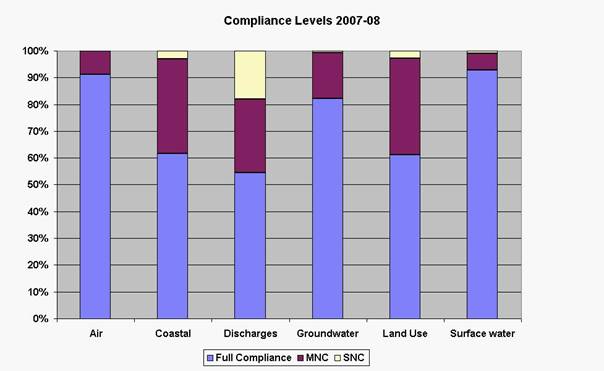
As can be seen, activities relating to the discharge of a substance into water or onto or into land had the highest rate of non-compliance. A high proportion of these discharges are of FDE. These results are discussed in more detail later in this report. Minor non-compliance in a consented discharge system can include incomplete maintenance and/or discharge records. Significant non-compliance can include exceeding consented discharge/receiving environment limits, leading to an adverse impact on the environment.
Incidents of significant non-compliance also include activities which have been undertaken outside of the conditions of resource consent, or a rule in a Regional Plan, but that have not yet had an adverse impact on the environment, i.e., the damage has not yet occurred but would have been unavoidable under different conditions. An example of this is earthworks operations undertaken on a slope without the specified sediment control features. Sediment run-off may not yet have occurred however it would be inevitable in the event of prolonged or heavy rainfall. Relying on the fact that this situation has not yet arisen is not an adequate defence under the RMA.
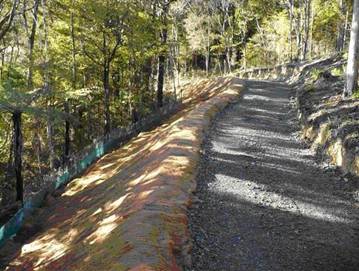
Photo: Sediment control features – full compliance
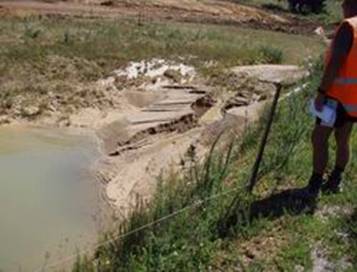
Photo: Poorly maintained sediment pond – minor non-compliance
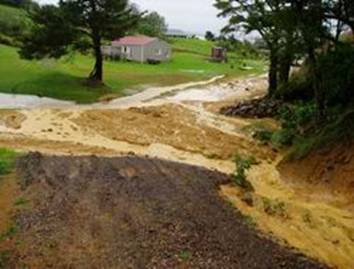
Photo: Sediment run-off from earthworks activity with no sediment control features – significant non-compliance
The second highest rate of non-compliance comes from coastal activities and the third from land-use. For coastal activities, the most frequently recorded minor non-compliance is that new or existing coastal structures are not numbered as stipulated. More significant non-compliance can include structures that are not the consented size. For land-use activities, minor non-compliance can include incorrect construction or maintenance of sediment control features used during earthworks activities. Significant non-compliance can include a complete lack of sediment control features, leading to excessive sediment run-off from earthworks activities.
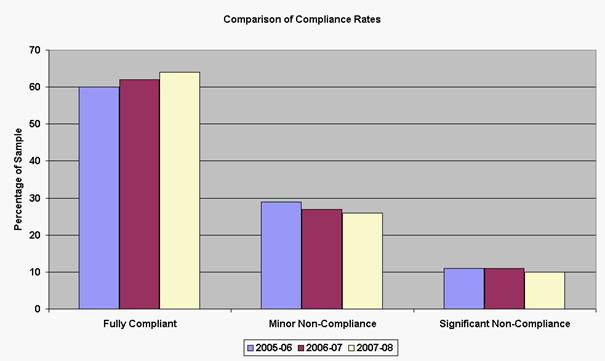
In 2007-08, there was a small increase in the number of consented activities that were fully compliant compared to the previous two years. In 2005-06, 60% of consented activities were fully compliant, in 2006-07 this rose to 62% and in 2007-08, this figure rose again to 64%. As a result, there has been a small decrease in the number of activities that have minor non-compliance from 29% in 2005-06 to 26% in 2007-08 and a small decrease in activities that are significantly non-compliant from 11% in 2005-06 to 10% in 2007-08.
